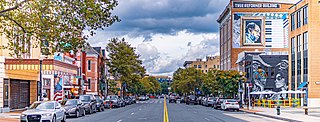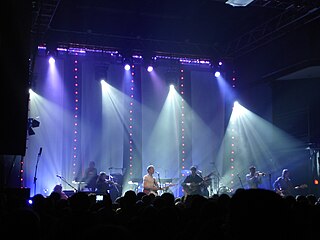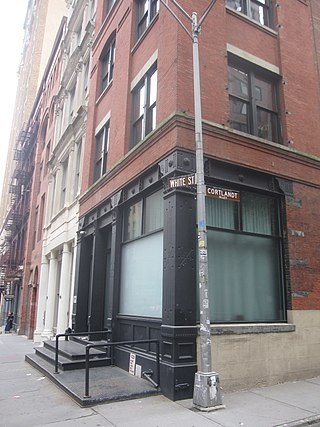
The punk subculture includes a diverse and widely known array of ideologies, fashion, and other forms of expression, visual art, dance, literature, and film. Largely characterised by anti-establishment views, the promotion of individual freedom, and the DIY ethics, the culture originated from punk rock.
Death rock is a rock music subgenre incorporating horror elements and gothic theatrics. It emerged from punk rock on the West Coast of the United States in the early 1980s and overlaps with the gothic rock and horror punk genres. Notable death rock acts include Christian Death, Kommunity FK, 45 Grave, and Super Heroines.
Psychobilly is a rock music fusion genre that fuses elements of rockabilly and punk rock. It's been defined as "loud frantic rockabilly music", it has also been said that it "takes the traditional countrified rock style known as rockabilly, ramp[ing] up its speed to a sweaty pace, and combin[ing] it with punk rock and imagery lifted from horror films and late-night sci-fi schlock,... [creating a] gritty honky tonk punk rock."

Washington, D.C., has been home to many prominent musicians and is particularly known for the musical genres of Jazz, Rhythm & Blues, bluegrass, punk rock and its locally-developed descendants hardcore and emo, and a local funk genre called go-go. The first major musical figure from District of Columbia was John Philip Sousa, a military brass band composer. Later figures include jazz musicians, such as Duke Ellington, Charlie Rouse, Buck Hill, Ron Holloway, Davey Yarborough, Michael A. Thomas, Butch Warren, and DeAndrey Howard; soul musicians, including Billy Stewart, The Unifics, The Moments, Ray, Goodman & Brown, Van McCoy, The Presidents, The Choice Four, Vernon Burch, guitarist Charles Pitts, and Sir Joe Quarterman & Free Soul.

Noise rock is a noise-oriented style of experimental rock that spun off from punk rock in the 1980s. Drawing on movements such as minimalism, industrial music, and New York hardcore, artists indulge in extreme levels of distortion through the use of electric guitars and, less frequently, electronic instrumentation, either to provide percussive sounds or to contribute to the overall arrangement.

The 9:30 Club is a nightclub and concert venue in Washington, D.C. In 2018, the 9:30 Club was named one of the 10 best live music venues in America by Rolling Stone, and in 2019 the club was named "Venue of the Decade" by VenuesNow.

The Little Band scene was an experimental post-punk scene which flourished in Melbourne, Victoria, Australia from late 1978 until early 1981. Instigated by groups Primitive Calculators and Whirlywhirld, this scene was concentrated in the inner suburbs of Fitzroy and St Kilda, and involved large numbers of short-lived bands, more concerned with artistic expression than commercial success. Frequently changing names, swapping members and sharing equipment, the bands played in small inner-city venues, often pubs, and their music was recorded live and broadcast by radio announcer Alan Bamford on community station 3RRR. In the scene, the distinctions between performers and audience were blurred; many audience members were either in little bands or ended up forming such.
Rock music entered the Peruvian scene in the late 1950s, through listening to performers like Elvis Presley, Buddy Holly and Bill Haley, who popularized rockabilly in the United States. The first Peruvian rock bands appeared during this time. They included Los Millonarios del Jazz, Los Stars, Conjunto Astoria, Los Incas Modernos, and Los Zodiacs.

Rock City is a music venue and nightclub located in Nottingham, England. It is owned by venue operator and concert promoter DHP Family.

The Mudd Club was a nightclub located at 77 White Street in the TriBeCa neighborhood of Lower Manhattan in New York City. It operated from 1978 to 1983 as a venue for post punk underground music and no wave counterculture events. It was opened by Steve Maas, Diego Cortez and Anya Phillips.

Jay's Longhorn Bar was a nexus of the punk rock and New Wave scenes in Minneapolis, Minnesota, in the late 1970s and early 1980s.

The Triple Rock Social Club was a bar, music venue, and restaurant in Minneapolis, Minnesota, United States, co-owned by Gretchen Funk and Erik Funk of the punk band Dillinger Four.

The Music in Leeds ecompasses a variety of styles and genres, including rock, pop and electronic. While groups like Soft Cell, the Kaiser Chiefs, the Wedding Present, Utah Saints and the Bridewell Taxis have gained success in the mainstream, Gang of Four, the Sisters of Mercy, Chumbawamba and the Mission have helped to define genres like punk rock, gothic rock and post-punk.

The music of Cardiff has been dominated mainly by rock music since the early 1990s with later trends developing towards more extreme styles of the genre such as heavy metal and metalcore music. It, along with the nearby music scene in Newport, has brought a number of musicians to perform or begin their careers in South Wales.

The 40 Watt Club is a music venue in Athens, Georgia. Along with CBGB, the Whisky a Go Go, and selected others, it was instrumental in launching American punk rock and new wave music.
Raul's was a live music nightclub at 2610 Guadalupe Street in Austin, Texas in the late 1970s and early 1980s, which started off as a Chicano music venue, but then specialized in punk rock music. The location is near the University of Texas campus.
Tier 3 was an influential but short-lived 300-capacity no wave art nightclub in New York. Founded by Hilary Jaeger in 1979, Tier 3 was a major venue in the city's underground music and counterculture post-punk art scene, along with the Mudd Club. Live performances showcased punk rock, no wave, ska, noise music, free jazz, new wave and experimental music. The club was located at 225 West Broadway in the TriBeCa neighborhood of lower Manhattan.
The Mr. Roboto Project is a Do It Yourself (DIY) nonprofit volunteer-run cooperative venue and show space in Pittsburgh, Pennsylvania. Since the fall of 2011, it has been located at 5106 Penn Avenue. The structure of The Mr. Roboto Project was modeled partially after the 924 Gilman St club in Berkeley, CA, combined with elements of the East End Food Co-op in Pittsburgh, PA.
The Harp Bar was a public house and live music venue based in Hill Street, central Belfast, Northern Ireland. It's notable in the context of punk rock history, particularly music from Northern Ireland. It was owned between 1977 and 1984 by Patrick (Patsy) Lennon who some years later built and owned the Limelight nightclub and Dome Bar.
The Philadelphia punk scene refers to the vibrant punk rock scene created in Philadelphia, Pennsylvania.













